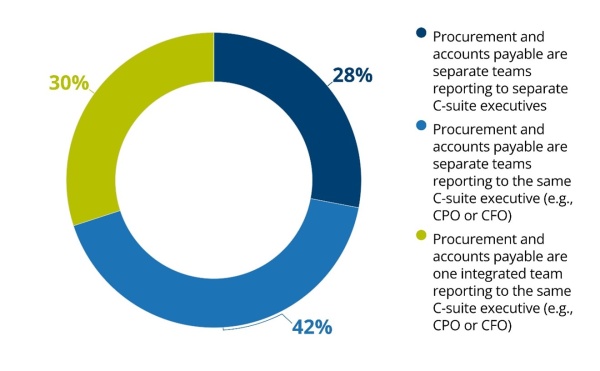
In response to increasing global interest in end-to-end processes, APQC has gathered insight into how organizations are governing and managing their procure-to-pay (P2P) processes. This end-to-end process begins with ordering goods and services, then receiving those goods and services, and finally paying for those goods and services.
A quick look at how P2P is being governed reveals a lack of integration between procurement and accounts payable (AP) in 70 percent of organizations.
Key Data Points from Organizations that Lack Procurement and Accounts Payable Integration
- In 28 percent of organizations, Procurement and AP are separate teams with separate reporting lines.
- In 42 percent of organizations, the two functions are separate teams that at least report to the same c-suite executive.
- Only 30 percent of organizations report having an integrated procure-to-pay team reporting to one executive.
P2P Process Governance
Challenges with Disconnected Procure-to-Pay Governance
A disconnected P2P process misses the vital step of considering not only the impact of procurement on payables and vice versa, but also the impact of suppliers’ actions on the organizations and the organization’s impact on its suppliers. Major disruptions in the supply chain have highlighted the impact of supplier risk on P2P for many organizations. It’s all interconnected, and decisions to pay suppliers slower, for example, can impact procurement’s relationship with that supplier as well as affect the suppliers’ working capital and future ability to continue providing goods and services.
Improving Procure-to-Pay Governance
One solution to this disconnect is to implement a global process owner. What does it take to be the global process owner? The process owner needs a holistic view of the end-to-end process to be accountable for it. From a leadership perspective, there are several skills required of a process owner that are not related to their expertise in either procurement or finance. A process owner needs strong soft skills, particularly the ability to bring people together across functions or units that have not worked together or are reluctant to change.
P2P process owners strive for standardized and streamlined processes that can then be effectively automated. By minimizing non-value-added activities, the process owner supports more time, effort, and energy for employees to focus on activities that are innovative and differentiate the business from its competitors.
To focus on effectively managing the end-to-end process, organizations need to shift from thinking of procurement and AP as separate processes and implement governance that enables them to become an integrated, seamless end-to-end process.
To learn more about the disconnect in governance between procurement and AP, download APQC’s article looking at the current state of P2P governance, highlights the challenges with a disconnected process, and provides guidance for how to better govern the P2P end-to-end process and Procure-to-Pay: Structure and Automation Survey Report.
To continue the conversation, follow Marisa on X at @MB_APQC or connect with her on LinkedIn.
